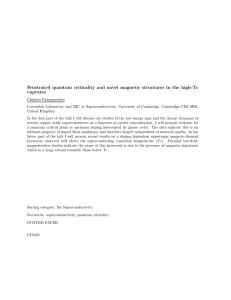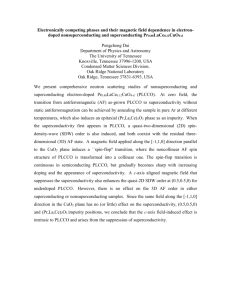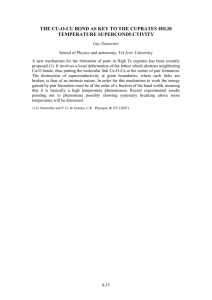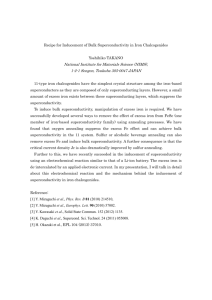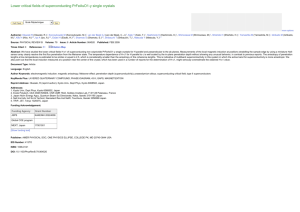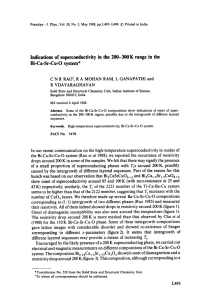Bipartite magnetic parent phases in the iron oxypnictide super
advertisement
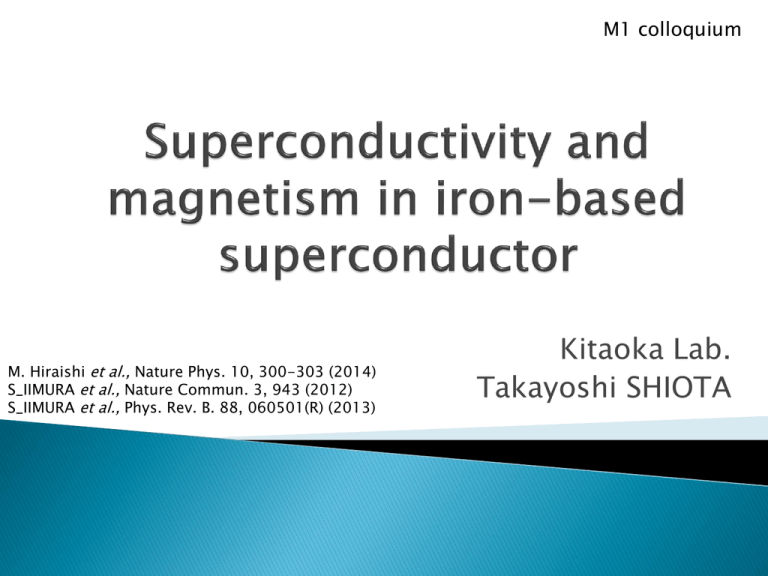
M1 colloquium M. Hiraishi et al., Nature Phys. 10, 300-303 (2014) S_IIMURA et al., Nature Commun. 3, 943 (2012) S_IIMURA et al., Phys. Rev. B. 88, 060501(R) (2013) Kitaoka Lab. Takayoshi SHIOTA Introduction Superconductivity(properties, history) Iron-based superconductor (structure, phase diagram) LaFeAs(O1-xFx) Results LaFeAs(O1-xHx) Experiment Theoretical calculation Summary introduction Zero resistivity Perfect diamagnetism http://allnewscience.blogspot.jp/2010/07/anti-gravity.html http://teachers.web.cern.ch/teachers/archiv/HST2001/accelerators/superconductivity/superconductivity.htm introduction 1911 Transition temperature (K) 200 metal heavy fermion system high-Tc cuprate 163 iron-based system 150 Discovery of superconducting phenomenon Hg-Ba-Ca-Cu-O (under high pressure ) Hg-Ba-Ca-Cu-O Tl-Ba-Ca-Cu-O 1979 Heavy fermion superconductor Bi-Sr-Ca-Cu-O 100 Y-Ba-Cu-O 1986 77 50 MgB2 Hg Pb La-Ba-Cu-O PuCoGa5 NbGe Nb NbC NbN CeCu2Si2 LaFeAsO0.89F0.11 LaFePO 0 1900 1920 1940 1960 1980 2000 2020 Year High-Tc cuprate superconductor SmFeAsO0.9F0.1 2006 Iron-based high-Tc superconductor introduction Pn Fe Iron Pnictides LnFePnO Ae4M2O6Fe2Pn2 Ln =La, Ce, Pr, Nd, Gd, Tb, Dy, Er, Y AeFe2Pn2 AFePn Ae =Ba, Sr, Ca, Eu A =Li, Na O M Ae Ln Ae A FeCh Ae2Fe4Ch5 Iron Chalcogenides introduction Pn hPn hPn ~ 1.38Å Fe α Regular tetrahedron α = 109.5゚ Mizuguchi et al. Supercond. Sci. Technol. 23 (2010) 054013. C. H. LEE et al. J. Phys. Soc. Jpn., Vol. 77, No. 8 introduction LnFeAsO introduction TS:Structural transition temperature T< TS LnFeAsO introduction TT<T <TNS TN:Magnetic transition temperature Stripe antiferromagnetic state LnFeAsO introduction TN:Magnetic transition temperature T< TN LnFeAs(O1-xFx) O2- = F- + eElectron doping introduction Tc:Superconducting transition temperature T< Tc LnFeAs(O1-xFx) O2- = F- + eElectron doping Superconducting state (cooper-pair) The correlation between magnetic/structural fluctuation and superconductivity? introduction Phase diagram Band structure E εF hole (π,0) Fermisurface Electron doping k Electron doping Nesting weak electron introduction AF:Antiferromagnetism SC:Superconductivity Nesting weak The disappearance of SC had not been confirmed Problem O2- → FLow solubility limit of F- in O2- O2 - → HHydrogen behaves H- in oxide Electron dopant as flourine High solubility limit! Results x=0.08 Tc=29K x x=0.01 kink in resistivity due to structural or magnetic transition was seen around 150K x≧0.08 zero resistivity due to superconductivity Tc =29K Tc =18K Results x=0.36 Tc =36K x x=0.08~0.53 zero resistivity due to superconductivity Results x=0.08 Tc=29K n=2 Fermi liquid state x=0.36 Tc =36K x 0.04<x<0.21: first dome(SC1) 0.21<x<0.53: second dome(SC2) n=1 Non-Fermi liquid state ρρ0 AT n Electronic state around x=0.40 is different from x=0.10 Why?? Results Weaker α-β nesting γ α x = 0.08 x=0.21 Stronger γ-β/β-β nesting x=0.40 β Results Χα-β Χγ-β 0≦x≦0.05 Large χα-β (π,0) induces stripe-type AFM ordering 0.05<x<0.20 Spin fluctuations at Q ∼ (π,0) develop x~0.20 Switching from χα-β to χγ -β 0.20<x χγ –β becomes stronger with increasing x Nesting weak x Results Electron doping Results Hole doping These experiment and theoretical calculation were performed in LaFeAs(O1-xHx). Two-dome superconducting phases (SC1,SC2) were found. The ground state is an antiferromagnetic ordering in 0≦x<0.05 (AFM1) and 0.40≦x≦0.51 (AFM2) . These results suggest that superconductivity relates to magnetism.

